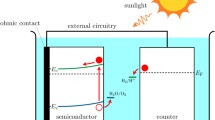Abstract
Increasing attention is being focused on the properties and behaviour of p-type semiconductor electrodes. For instance, p-type GaP electrodes have been used in photoelectrochemical cells for water splitting1, CO2 reduction2 and N2 fixation3. We report here the quantum efficiency–potential characteristics for H2 evolution at an irradiated p-GaP electrode. The curves have been evaluated using a Schottky barrier model of the semiconductor/electrolyte interface4.
Similar content being viewed by others
References
Ohashi, K., McCann, J. & Bockris, J. O'M. Nature 266, 610 (1977).
Halmann, M. Nature 275, 115 (1978).
Dickson, C. R. & Nozik, A. J. J. Am. chem. Soc. 100, 8007 (1978).
Gartner, W. W. Phys. Rev. 116, 84 (1959).
Ohashi, K., McCann, J. & Bockris, J. O'M.Int. J. Energy Res. 1, 259 (1977).
Beckmann, K. H. & Memming, R. J. electrochem. Soc. 116, 388 (1969).
Bockris, J. O'M. & Uosaki, K. J. electrochem. Soc. 125, 223 (1978).
Author information
Authors and Affiliations
Rights and permissions
About this article
Cite this article
McCann, J., Handley, L. The photoelectrochemical effect at a p-GaP electrode. Nature 283, 843–845 (1980). https://doi.org/10.1038/283843a0
Received:
Accepted:
Issue Date:
DOI: https://doi.org/10.1038/283843a0
- Springer Nature Limited
This article is cited by
-
Direct Band Gap Gallium Antimony Phosphide (GaSbxP1−x) Alloys
Scientific Reports (2016)





